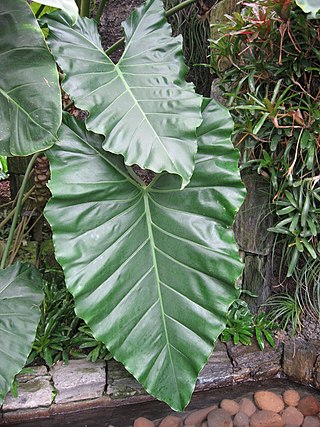
Anthurium is a genus of about 1,000 species of flowering plants, the largest genus of the arum family, Araceae. General common names include anthurium, tailflower, flamingo flower, and laceleaf.

Dracontium is a genus of flowering plants similar to those of Amorphophallus. Unlike Amorphophallus which is found in the Old World, this genus has a New World distribution and is native to South America, Central America, southern Mexico, and the West Indies.

Heteropsis is a genus of plants in the family Araceae, native to Central and South America.

Urospatha is a genus of flowering plants in the family Araceae that consists of approximately 10 known species. They are found growing in South America and Central America in swamps, wet savannahs, and brackish water. The leaves of the species in this genus are upward pointing and sagittate (arrow-shaped). The inflorescences are quite unique; the spathe is mottled and elongated with a spiral twist at the end. The seeds are distributed by water and have a texture similar to cork that allows them to float. They also quickly germinate in water.
Anaphyllopsis is a genus of flowering plants in the family Araceae, native to northern South America.
Zomicarpella is a genus of flowering plants in the family Araceae. It is native to Colombia, Peru and Brazil. The leaves are hastate or sagittate. The chromosome number for Zomicarpella species is 2n=26. Additionally, the seeds have an endosperm.
- Zomicarpella amazonicaBogner - Amazonas State of northwestern Brazil
- Zomicarpella maculataN.E.Br. - Colombia, Peru
Mangonia is a genus of flowering plants in the family Araceae. The genus contains only two known species native to southern Brazil and Uruguay.
- Mangonia tweedieanaSchott. - Rio Grande do Sul, Uruguay
- Mangonia uruguaya(Hicken) Bogner - Cerro Largo in Uruguay
Gorgonidium is a genus of flowering plants in the family Araceae. It is native to South America. The spathes tend to be purple and the fruits are black.
- Gorgonidium beckianumBogner - Bolivia
- Gorgonidium bulbostylumBogner & E.G.Gonç - Bolivia
- Gorgonidium cardenasianum(Bogner) E.G.Gonç - Bolivia
- Gorgonidium intermedium(Bogner) E.G.Gonç - Peru
- Gorgonidium mirabileSchott - Bolivia
- Gorgonidium striatumHett., Ibisch & E.G.Gonç
- Gorgonidium vargasiiBogner & Nicolson - Peru
- Gorgonidium vermicidum(Speg.) Bogner & Nicolson - Bolivia, northern Argentina
Scaphispatha gracilis is a species in the family Araceae. This species is native to Brazil and Bolivia, and has peltate leaves that resembles those in the genus Caladium. The species was described by Heinrich Wilhelm Schott in 1860 after he received an inflorescence of the plant. He had not however seen the plant itself and it was not rediscovered until 1976 when Josef Bogner collected tubers from the plant and successfully flowered them at the Munich Botanic Garden. Upon seeing the inflorescence it was realized that this was the plant Schott had originally described.
Spathantheum is a genus of flowering plants in the family Araceae. The genus contains two species, Spathantheum fallax and Spathantheum orbignyanum. Spathantheum is believed to be closely related to Spathicarpa. The genus is endemic to the Andes of Peru, Bolivia, and northern Argentina and is found growing in grasslands in rocky soil.
- Spathantheum fallax Hett., Ibisch & E.G.Gonç. - Bolivia
- Spathantheum orbignyanumSchott - Peru, northwestern Argentina, Bolivia

Spathicarpa is a genus of flowering plants in the family Araceae, all of which are endemic to South America. Spathicarpa species are notable for the fact that the entirety of their spadix is fused to the spathe. The genus is believed to be closely related to Spathantheum. The tribe Spathicarpeae is named after the genus Spathicarpa.

Taccarum is a genus of flowering plants in the family Araceae. It is endemic to South America. The genus tends to grow in rocky areas.
- Taccarum caudatumRusby - Bolivia, Peru, Acre State in western Brazil
- Taccarum crassispathumE.G.Gonç. - central Brazil
- Taccarum peregrinum(Schott) Engl. - Paraguay, southern Brazil, Misiones Province of Argentina
- Taccarum uleiEngl. & K.Krause - eastern Brazil
- Taccarum warmingiiEngl. - southern Brazil
- Taccarum weddellianumBrongn. ex Schott - Bolivia, Peru, Paraguay, central and western Brazil
Scaphispatha is a genus of flowering plants in the family Araceae. It contains two species, S. gracilis and S. robusta. The genus was believed to be monotypic until 2003 when a new species, S. robusta was discovered by Eduardo Gomes Gonçalves in northern Brazil. The plant had been grown in cultivation for some years, but had always been assumed to be a Caladium until it flowered.
- Scaphispatha gracilisBrongn. ex Schott - Bolivia, Brazil
- Scaphispatha robustaE.G.Gonç. - Pará, Mato Grosso, Tocantins, Goiás

Philodendron maximum is a species of flowering plant in the family Araceae and genus Philodendron. It is native to Bolivia, Ecuador, and western Brazil in the States of Acre and Mato Grosso.

Thaumatophyllum speciosum is a species of plant in the family Araceae, native to Brazil and Bolivia.
Incarum is a genus of plants in the family Araceae. It has only one known species, Incarum pavonii, native to western South America.
Philonotion is a genus of plants in the family Araceae. It has three known species, native to tropical South America. Some authorities regard it as part of the related genus Schismatoglottis.
- Philonotion americanum(A.M.E.Jonker & Jonker) S.Y.Wong & P.C.Boyce - Brazil, Colombia, Venezuela, the Guianas
- Philonotion bolivaranum(G.S.Bunting & Steyerm.) S.Y.Wong & P.C.Boyce - Venezuela
- Philonotion spruceanumSchott - Venezuela, Colombia, Peru, Bolivia, northwestern Brazil

Siphoneugena is a genus of the botanical family Myrtaceae, first described as a genus in 1856. It is native to Central and South America as well as the West Indies.
Alloschemone inopinata is a species of flowering plant in the genus Alloschemone of the arum family Araceae.
Alloschemone occidentalis is a flowering plant in genus Alloschemone of the arum family Araceae.








